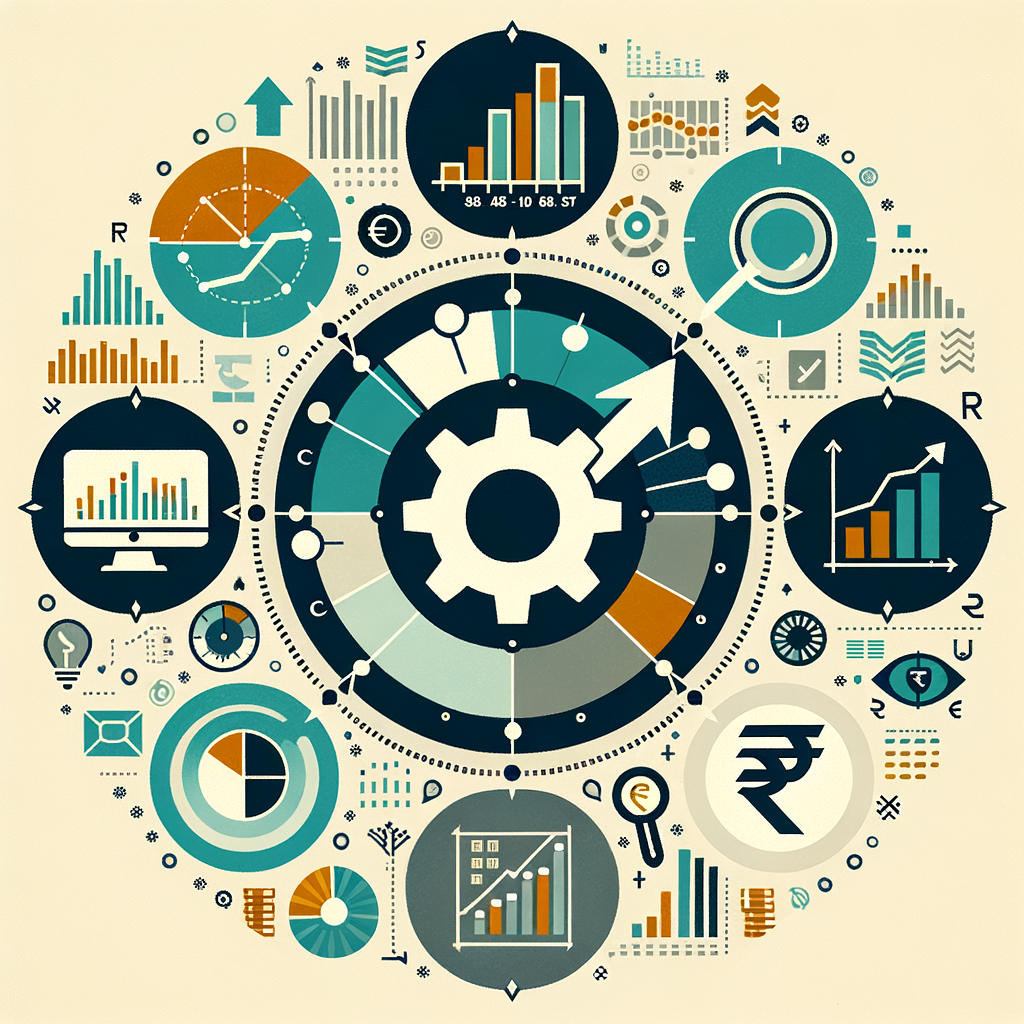Using Economic Indicators to Predict Market Trends in India: A Practical Guide
Ever felt like the Indian market has a mind of its own? One month your sales are soaring, and the next, the stock market takes a dip that sends shivers down your spine. What if you could anticipate these shifts instead of just reacting to them? The secret isn’t a crystal ball; it’s understanding the signals the economy sends out. This guide will demystify how to use economic indicators to predict market trends in India. We’ll break down the most important indicators and show you how to apply this knowledge, whether you’re a small business owner planning your next move or a salaried individual managing your investments. This process of economic trends analysis India can give you a significant advantage in making smarter financial decisions.
What Are Economic Indicators and Why Do They Matter in India?
Understanding the economy might seem like a job for experts in Delhi, but the data they use is accessible to everyone and has a direct impact on your financial life. By learning to read these signals, you can move from being a passenger to a navigator in your financial journey.
Defining Economic Indicators: The Economy’s Health Report
In the simplest terms, economic indicators are official statistics about economic activity. Think of them as a doctor’s report for the country’s financial health. Just as a blood report shows cholesterol and sugar levels, these indicators show signs of growth (a strong heartbeat), stability (healthy blood pressure), or weakness (a worrying symptom). They help policymakers, businesses, and investors understand where the economy has been, where it is now, and where it might be heading.
These indicators are broadly categorized into three types:
- Leading Indicators: These try to predict future economic activity. For example, a sharp increase in building permits suggests a construction boom is on the horizon.
- Lagging Indicators: These confirm trends that have already happened. Corporate profit reports, for instance, tell you how companies performed in the last quarter.
- Coincident Indicators: These show the current state of the economy. Personal income figures reflect what is happening right now.
The Importance for Indian Businesses and Investors
For small business owners and individual investors, these numbers are not just abstract data points; they are tools for strategic planning. Understanding market trends with economic indicators helps you make proactive decisions rather than reactive ones. For a small business, this means better inventory planning based on anticipated consumer demand, refining pricing strategies to account for inflation, making informed hiring decisions, and knowing the best time to apply for a business loan. For salaried individuals and investors, this knowledge is equally powerful. These indicators directly influence stock market performance, the returns on your mutual funds, the interest you earn on fixed deposits, and the EMI you pay on your loans. Ultimately, a solid grasp of market trends analysis India is a cornerstone of effective financial management and wealth creation.
Key Economic Indicators to Predict Market Trends in India
To get started, you don’t need to track dozens of complex data points. Focusing on a handful of the most influential ones can provide a clear picture of the economic landscape. Here are the top five indicators you must track for effective market trends prediction in India. We’ll explain what each means, where to find the official data, and how it impacts the market.
1. Gross Domestic Product (GDP)
What it is: The Gross Domestic Product (GDP) is the most comprehensive measure of a country’s economic health. It represents the total monetary value of all final goods and services produced within India during a specific period, usually a quarter or a year. In essence, it’s the final price tag on everything the country produced. A rising GDP indicates that the economy is growing, while a falling GDP signals a contraction.
How it predicts trends: The direction of GDP growth is a powerful signal for future market performance.
- High GDP Growth (>6-7%): This signals a robust and expanding economy. Businesses can expect higher consumer spending and increased demand for their products and services. For investors, this environment is typically bullish for the stock market, as corporate earnings tend to rise, driving stock prices up.
- Low GDP Growth (<5%): This suggests an economic slowdown. Businesses may face weaker sales and might need to cut costs. Investors should become more cautious, as corporate profits may shrink, leading to a bearish or stagnant market.
Where to find data: The official GDP figures are released quarterly by the National Statistical Office (NSO), which operates under the Ministry of Statistics and Programme Implementation.
2. Inflation (CPI & WPI)
What they are: Inflation measures the rate at which the general level of prices for goods and services is rising, and subsequently, purchasing power is falling. In India, we primarily track two types:
- Consumer Price Index (CPI): Often called retail inflation, the CPI measures the average change in prices that you, the consumer, pay for a basket of common goods and services like food, housing, and transportation. This is the indicator the RBI watches most closely for its policy decisions.
- Wholesale Price Index (WPI): This tracks the price changes of goods sold in bulk by wholesale businesses to other businesses. It’s a key indicator of producer-side inflation.
How they predict trends: High inflation is a double-edged sword. While moderate inflation can be a sign of a healthy, growing economy, persistently high inflation erodes the value of money. This reduces consumer purchasing power, meaning your money buys less than it used to. To combat this, the Reserve Bank of India (RBI) often raises interest rates. Higher interest rates make borrowing more expensive for both businesses and consumers, which can slow down economic growth and negatively affect stock market returns. This dynamic is a core part of economic indicators and market forecasting.
Where to find data: CPI data is released monthly by the NSO, while WPI data is released by the Office of the Economic Adviser, Ministry of Commerce and Industry. Both are closely tracked and reported by the Reserve Bank of India (RBI).
3. Interest Rates (RBI Repo Rate)
What it is: The Repo Rate is the interest rate at which the Reserve Bank of India lends money to commercial banks. It is the RBI’s primary tool for controlling inflation and managing economic growth. This single rate influences the interest rates that banks charge you for home loans, car loans, personal loans, and business loans, as well as the rates they offer on fixed deposits.
How it predicts trends: The direction of the repo rate sends a clear signal about the future cost of money, which has a massive impact on the entire economy.
- Lower Rates (Rate Cut): When the RBI cuts the repo rate, it becomes cheaper for commercial banks to borrow money. They, in turn, pass on these benefits to consumers and businesses through lower loan rates. This encourages spending and investment, fuels business expansion, and is generally seen as a positive catalyst for the stock market.
- Higher Rates (Rate Hike): When the RBI increases the repo rate, borrowing becomes more expensive. This is usually done to control high inflation. It discourages spending and can slow down business investment, which can cool down an overheating economy and may have a negative short-term impact on the stock market.
Where to find data: The RBI’s Monetary Policy Committee (MPC) meets every two months to decide on the repo rate. Their decisions are announced via official RBI press releases.
4. Index of Industrial Production (IIP)
What it is: The Index of Industrial Production (IIP) is a composite indicator that measures the growth rate of various industry groups in the economy. It provides a monthly snapshot of the health of core industrial sectors like manufacturing, mining, and electricity. Since the industrial sector is a major component of GDP, the IIP acts as a short-term proxy for industrial and, by extension, economic health.
How it predicts trends: The IIP is a leading indicator for corporate earnings, especially for companies in the manufacturing and infrastructure sectors. A strong, consistently rising IIP suggests that industrial activity is robust, factories are busy, and demand is high. This often translates directly into higher revenues and profits for listed companies, leading to a positive outlook for the stock market. Conversely, a declining IIP is a red flag, signaling a potential slowdown in the economy. This is a classic example of market trend analysis using economic indicators.
Where to find data: The IIP data is released monthly by the National Statistical Office (NSO).
5. Fiscal Deficit
What it is: The fiscal deficit is the difference between the government’s total expenditure and its total revenue (excluding borrowings). Simply put, it tells you how much money the government has to borrow to meet its expenses for the year. A well-managed fiscal deficit is a sign of a government’s financial discipline.
How it predicts trends: While it may seem like a government-level issue, the fiscal deficit has wide-ranging implications. A consistently high fiscal deficit means the government is borrowing heavily from the market. This increased demand for money can “crowd out” private investment and put upward pressure on interest rates. It can also lead to higher inflation if the government resorts to printing more money to finance its deficit. International rating agencies watch this number closely, and a high deficit can lead to a credit rating downgrade, which can spook foreign investors. Therefore, analyzing economic indicators for market trends must include a careful look at the government’s financial health.
Where to find data: The fiscal deficit target and performance are key highlights of the annual Union Budget presented by the Ministry of Finance.
How to Apply This Knowledge: A Practical Guide
Understanding these indicators is one thing; using them to make real-world decisions is another. Here’s a simple breakdown of how you can apply this knowledge.
For Small Business Owners
Inventory & Staffing: In a high GDP growth phase with a rising IIP, anticipate stronger consumer demand. This is the time to plan for higher inventory levels and consider hiring new staff to meet the expected workload. Conversely, during a slowdown signaled by low GDP growth, focus on lean operations and efficient inventory management to avoid being stuck with unsold stock. Proper financial management is key, and A Guide to Budgeting and Financial Planning for Startups can provide a solid framework.
Pricing Strategy: Keep a close eye on CPI inflation. During periods of high inflation, your input costs (raw materials, transport) are likely to rise. You may need to strategically adjust your product or service prices to protect your profit margins without alienating customers.
Expansion & Loans: The RBI’s repo rate is your cue for major capital expenditure. The ideal time to take out a Bank Loan for Startup Business for expansion, purchasing new equipment, or opening a new branch is when the RBI is in a rate-cutting cycle, as this will result in a lower interest burden for your business.
For Salaried Individuals & Investors
Equity Investments: A growing GDP, a strong IIP, and a stable interest rate environment often signal a bull market. This can be a favorable time to increase your investments in stocks and equity mutual funds, as corporate earnings are likely to be strong. It’s also crucial to understand the tax implications of these investments by Understanding Capital Gains Tax in India.
Debt Investments: When the RBI is raising interest rates to combat inflation, fixed-income instruments become more attractive. This is a good time to consider locking in higher interest rates on Fixed Deposits (FDs), Public Provident Fund (PPF), and government bonds.
Loan Planning: If you’re planning a big-ticket purchase that requires a loan, like a home or a car, track the repo rate trend. Planning your purchase during a period when interest rates are trending downwards can save you thousands or even lakhs of rupees in EMI payments over the loan’s tenure.
Conclusion: Making Smarter Decisions with Economic Data
Mastering the art of using economic indicators to predict market trends doesn’t require you to be an economist. It’s about being an informed participant in the economy. By regularly tracking key metrics like GDP, inflation, interest rates, IIP, and the fiscal deficit, you can move beyond speculation and make more strategic, confident financial decisions in the dynamic Indian economy. These indicators provide the crucial “why” behind the market’s movements, acting as a compass to help you navigate your business or investment journey.
Understanding these trends is the first step. The next is applying them to your specific financial situation. For expert guidance on business accounting, tax planning, and financial strategy that aligns with the market, connect with the experts at TaxRobo today.
Frequently Asked Questions (FAQs)
Q1. Which is the most important economic indicator for the Indian stock market?
A: While all are important and interconnected, GDP growth and the RBI’s interest rate decisions often have the most immediate and significant impact on overall market sentiment and direction. A strong GDP report can lift the entire market, while an unexpected interest rate hike can cause a sudden downturn.
Q2. How often is this economic data released in India?
A: The release frequency varies for each indicator. GDP data is released quarterly. CPI inflation and IIP data are released on a monthly basis. The RBI’s repo rate decision is announced bi-monthly (every two months) after its Monetary Policy Committee (MPC) meeting.
Q3. Can I rely solely on economic indicators for my business or investment decisions?
A: No. Economic indicators are powerful tools for understanding the broader macroeconomic environment (market trends analysis India), but they should not be your only tool. They must be used alongside other forms of analysis. For investors, this means conducting company-specific research (fundamental and technical analysis). For business owners, it means analyzing your specific industry, local market conditions, and competition. Economic indicators tell you about the economic climate, not about the unique prospects of a single stock or your local storefront.
Q4. Where can I find a reliable, consolidated source for all this Indian economic data?
A: The most reliable sources are the official government websites themselves. These include the Reserve Bank of India (RBI), the National Statistical Office (NSO), and the Ministry of Finance. Additionally, major financial news portals and publications in India do an excellent job of consolidating and reporting this data as soon as it is released.



